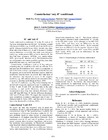Counterfactual ‘only if ’ conditionals
| dc.contributor.creator | Egan, Suzanne M. | |
| dc.contributor.creator | Byrne, Ruth M.J. | |
| dc.contributor.creator | García-Madruga, Juan A. | |
| dc.date.accessioned | 2018-12-11T10:44:32Z | |
| dc.date.available | 2018-12-11T10:44:32Z | |
| dc.date.issued | 2003 | |
| dc.identifier.citation | Suzanne Egan. “Counterfactual ‘only if’ conditionals”, 25th Annual Cognitive Science Conference, Boston, MA. Aug 2003. (Refereed). | en_US |
| dc.identifier.issn | 1069-7977 | |
| dc.identifier.uri | http://hdl.handle.net/10395/2542 | |
| dc.description | Counterfactual ‘only if ’ conditionals. | en_US |
| dc.description.abstract | People understand a conditional, 'if A then B', such as 'if Peg went swimming then she felt well' by keeping in mind only true possibilities, e.g., A and B, not-A and not-B, not-A and B (Johnson-Laird & Byrne, 2002). Initially they think about only a few of them, e.g., A and B, because of working memory limitations. As a result, they make some inferences readily e.g., modus ponens (MP), given A, therefore B. But they find other inferences difficult, e.g., modus tollens (MT), given not-B, therefore not-A. The information does not correspond to their initial possibility and they must think about other true ones, e.g., not-A and not-B. | en_US |
| dc.language.iso | eng | en_US |
| dc.publisher | Cognitive Science Society | en_US |
| dc.relation.ispartofseries | 25;25 | |
| dc.rights.uri | https://escholarship.org/uc/item/373511jh | en_US |
| dc.subject | Counterfactual | en_US |
| dc.subject | Conditionals | en_US |
| dc.subject | Only | en_US |
| dc.subject | If | en_US |
| dc.title | Counterfactual ‘only if ’ conditionals | en_US |
| dc.type | Conference report | en_US |
| dc.type.supercollection | all_mic_research | en_US |
| dc.type.supercollection | mic_published_reviewed | en_US |
| dc.description.version | Yes | en_US |


